Hybrid Bermudagrass and Tall Fescue Turfgrass Irrigation in Central California: I. Assessment of Visual Quality, Soil Moisture and Performance of an ET-Based Smart Controller
Abstract
:1. Introduction
2. Materials and Methods
2.1. Study Area
2.2. Irrigation Trials
2.3. Data Collection and Statistical Analysis
2.4. Turfgrass Water Response Function (TWRF)
3. Results
3.1. Performance of the Smart ET-Based Controller
3.2. Impact of Irrigation Levels and Frequency on Turfgrass Visual Ratings
3.3. Impact of Irrigation Treatments on Near-Surface Soil Moisture Dynamics
3.4. Turfgrass Water Response Function (TWRF)
4. Discussion
4.1. Performance of the Smart ET-Based Controller
4.2. Turfgrass Irrigation Management
5. Conclusions
Author Contributions
Funding
Institutional Review Board Statement
Informed Consent Statement
Conflicts of Interest
References
- CSDO. Population Projections Methodology (2019 Baseline); 2020. Available online: https://www.dof.ca.gov/forecasting/demographics/projections (accessed on 20 August 2021).
- UCANR. STRATEGIC VISION 2025: University of California Division of Agriculture and Natural Resources. 2019. Available online: https://ucanr.edu/files/906.pdf (accessed on 20 August 2021).
- Cook, B.I.; Ault, T.R.; Smerdon, J.E. Unprecedented 21st century drought risk in the American Southwest and Central Plains. Sci. Adv. 2015, 1, e1400082. [Google Scholar] [CrossRef] [Green Version]
- Cooley, H. Urban and Agricultural Water Use in California, 1960–2015; Pacific Institute: Oakland, CA, USA, 2020. [Google Scholar]
- Cardenas, B.; Dukes, M.D. Soil moisture sensor irrigation controllers and reclaimed water; Part I: Field-plot study. Appl. Eng. Agric. 2016, 32, 217–224. [Google Scholar]
- Davis, S.; Dukes, M.D.; Miller, G. Landscape irrigation by evapotranspiration-based irrigation controllers under dry conditions in Southwest Florida. Agric. Water Manag. 2009, 96, 1828–1836. [Google Scholar] [CrossRef]
- Haghverdi, A.; Singh, A.; Sapkota, A.; Reiter, M.; Ghodsi, S. Developing irrigation water conservation strategies for hybrid bermudagrass using an evapotranspiration-based smart irrigation controller in inland southern California. Agric. Water Manag. 2021, 245, 106586. [Google Scholar] [CrossRef]
- Singh, A.; Haghverdi, A.; Nemati, M.; Hartin, J. Efficient Urban Water Management: Smart Weather-Based Irrigation Controllers; UCANR Publication, 2020; p. 8674. Available online: https://anrcatalog.ucanr.edu/pdf/8674.pdf (accessed on 20 August 2021).
- Dukes, M. Water conservation potential of landscape irrigation smart controllers. Trans. ASABE 2012, 55, 563–569. [Google Scholar] [CrossRef]
- Devitt, D.; Carstensen, K.; Morris, R. Residential water savings associated with satellite-based ET irrigation controllers. J. Irrig. Drain. Eng. 2008, 134, 74–82. [Google Scholar] [CrossRef]
- Davis, S.L.; Dukes, M.D. Importance of ET controller program settings on water conservation potential. Appl. Eng. Agric. 2016, 32, 251–262. [Google Scholar]
- Bijoor, N.S.; Pataki, D.E.; Haver, D.; Famiglietti, J.S. A comparative study of the water budgets of lawns under three management scenarios. Urban Ecosyst. 2014, 17, 1095–1117. [Google Scholar] [CrossRef] [Green Version]
- Service, N.P. Benefits of Turf Grass. In Turf Management; 2018. Available online: https://www.nps.gov/subjects/turfmanagement/benefits.htm (accessed on 20 August 2021).
- Hartin, J.; Oki, L.; Fujino, D.; Reid, K.; Ingels, C.; Haver, D.; Baker, W. UC ANR research and education influences landscape water conservation and public policy. Calif. Agric. 2019, 73, 25–32. [Google Scholar] [CrossRef]
- Haghverdi, A.; Reiter, M.; Singh, A.; Sapkota, A. Hybrid Bermudagrass and Tall fescue Irrigation in Central California: II. Assessment of NDVI, CWSI and Canopy Temperature Dynamics. Agronomy 2021. submit. [Google Scholar]
- Haghverdi, A.; Najarchi, M.; Öztürk, H.S.; Durner, W. Studying Unimodal, Bimodal, PDI and Bimodal-PDI Variants of Multiple Soil Water Retention Models: I. Direct Model Fit Using the Extended Evaporation and Dewpoint Methods. Water 2020, 12, 900. [Google Scholar] [CrossRef] [Green Version]
- Hargreaves, G.H.; Samani, Z.A. Reference crop evapotranspiration from temperature. Appl. Eng. Agric. 1985, 1, 96–99. [Google Scholar] [CrossRef]
- Morris, K.N.; Shearman, R.C. NTEP turfgrass evaluation guidelines. In Proceedings of the NTEP Turfgrass Evaluation Workshop, Beltsville, MD, USA, 17 October 1998; pp. 1–5. [Google Scholar]
- SAS Institute. Base SAS 9.4 Procedures Guide; SAS Institute, 2015. Available online: https://documentation.sas.com/doc/en/pgmsascdc/9.4_3.5/procstat/titlepage.htm (accessed on 20 August 2021).
- Sanders, J. Veusz-a Scientific Plotting Package. 2008. Available online: https://veusz.github.io/ (accessed on 20 August 2021).
- Davis, S.; Dukes, M. Irrigation scheduling performance by evapotranspiration-based controllers. Agric. Water Manag. 2010, 98, 19–28. [Google Scholar] [CrossRef]
- Grabow, G.; Ghali, I.; Huffman, R.; Miller, G.; Bowman, D.; Vasanth, A. Water application efficiency and adequacy of ET-based and soil moisture–based irrigation controllers for turfgrass irrigation. J. Irrig. Drain. Eng. 2013, 139, 113–123. [Google Scholar] [CrossRef]
- Davis, S.; Dukes, M.D.; Vyapari, S.; Miller, G.L. Evaluation and demonstration of evapotranspiration-based irrigation controllers. In Proceedings of the World Environmental and Water Resources Congress 2007: Restoring Our Natural Habitat, Tampa, FL, USA, 15–19 May 2007; pp. 1–18. [Google Scholar]
- Colmer, T.D.; Barton, L. A review of warm-season turfgrass evapotranspiration, responses to deficit irrigation, and drought resistance. Crop Sci. 2017, 57, S-98–S-110. [Google Scholar] [CrossRef]
- Wherley, B.; Dukes, M.; Cathey, S.; Miller, G.; Sinclair, T. Consumptive water use and crop coefficients for warm-season turfgrass species in the Southeastern United States. Agric. Water Manag. 2015, 156, 10–18. [Google Scholar] [CrossRef]
- Richie, W.; Green, R.; Klein, G.; Hartin, J. Tall fescue performance influenced by irrigation scheduling, cultivar, and mowing height. Crop Sci. 2002, 42, 2011–2017. [Google Scholar] [CrossRef] [Green Version]
- Brown, C.; Devitt, D.; Morris, R. Water use and physiological response of tall fescue turf to water deficit irrigation in an arid environment. HortScience 2004, 39, 388–393. [Google Scholar] [CrossRef] [Green Version]
- Ervin, E.H.; Koski, A.J. Drought avoidance aspects and crop coefficients of Kentucky bluegrass and tall fescue turfs in the semiarid west. Crop Sci. 1998, 38, 788–795. [Google Scholar] [CrossRef]
- Schiavon, M.; Pornaro, C.; Macolino, S. Tall Fescue (Schedonorus arundinaceus (Schreb.) Dumort.) Turfgrass Cultivars Performance under Reduced N Fertilization. Agronomy 2021, 11, 193. [Google Scholar] [CrossRef]
- Hong, M.; Bremer, D.; Keeley, S. Minimum water requirements of cool-season turfgrasses for survival and recovery after prolonged drought. Crop Sci. 2020, 5. [Google Scholar] [CrossRef]
- Su, K.; Bremer, D.J.; Keeley, S.J.; Fry, J.D. Rooting characteristics and canopy responses to drought of turfgrasses including hybrid bluegrasses. Agron. J. 2008, 100, 949–956. [Google Scholar] [CrossRef]
- Sinclair, T.R.; Schreffler, A.; Wherley, B.; Dukes, M.D. Irrigation frequency and amount effect on root extension during sod establishment of warm-season grasses. HortScience 2011, 46, 1202–1205. [Google Scholar] [CrossRef] [Green Version]
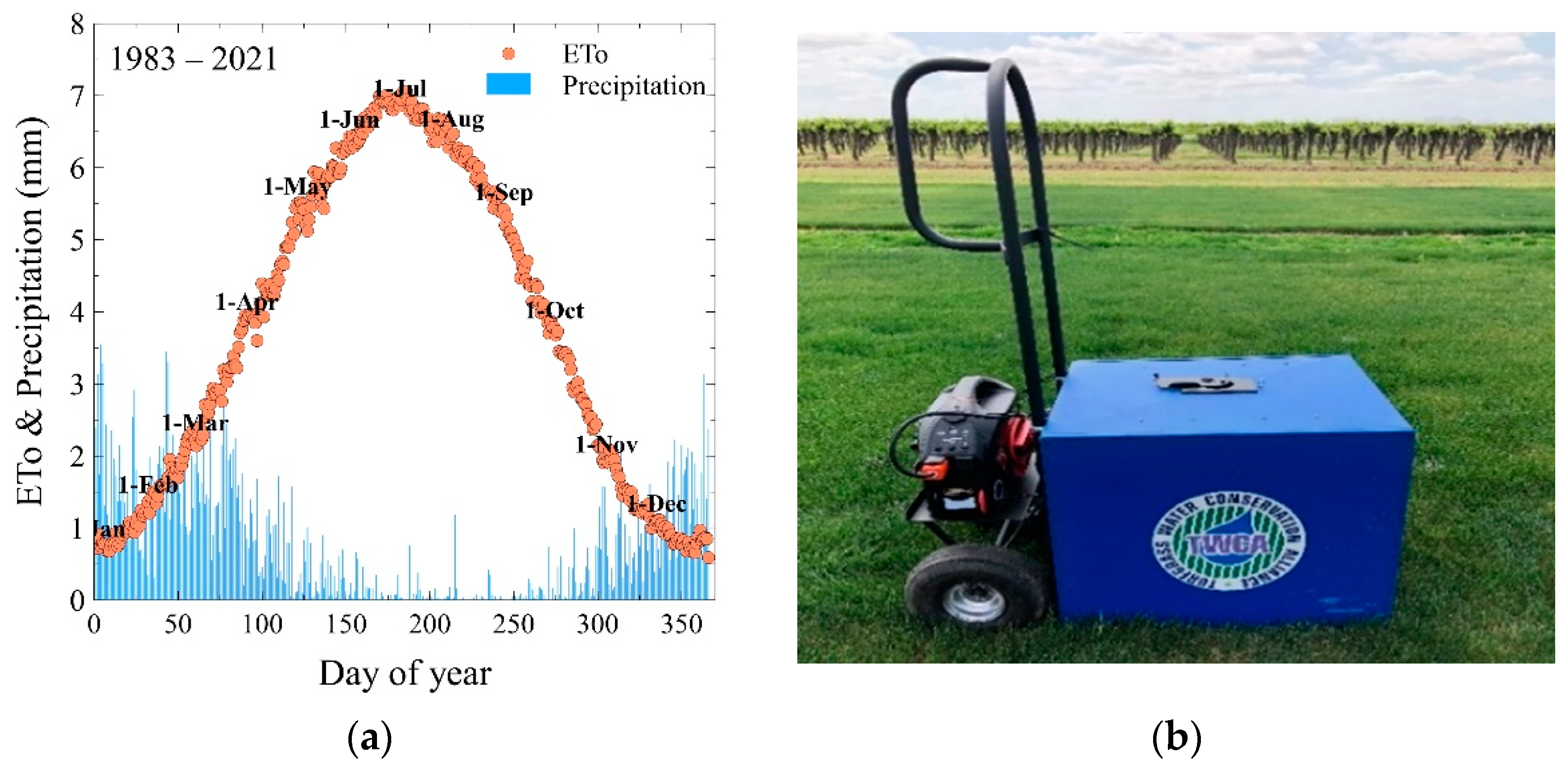
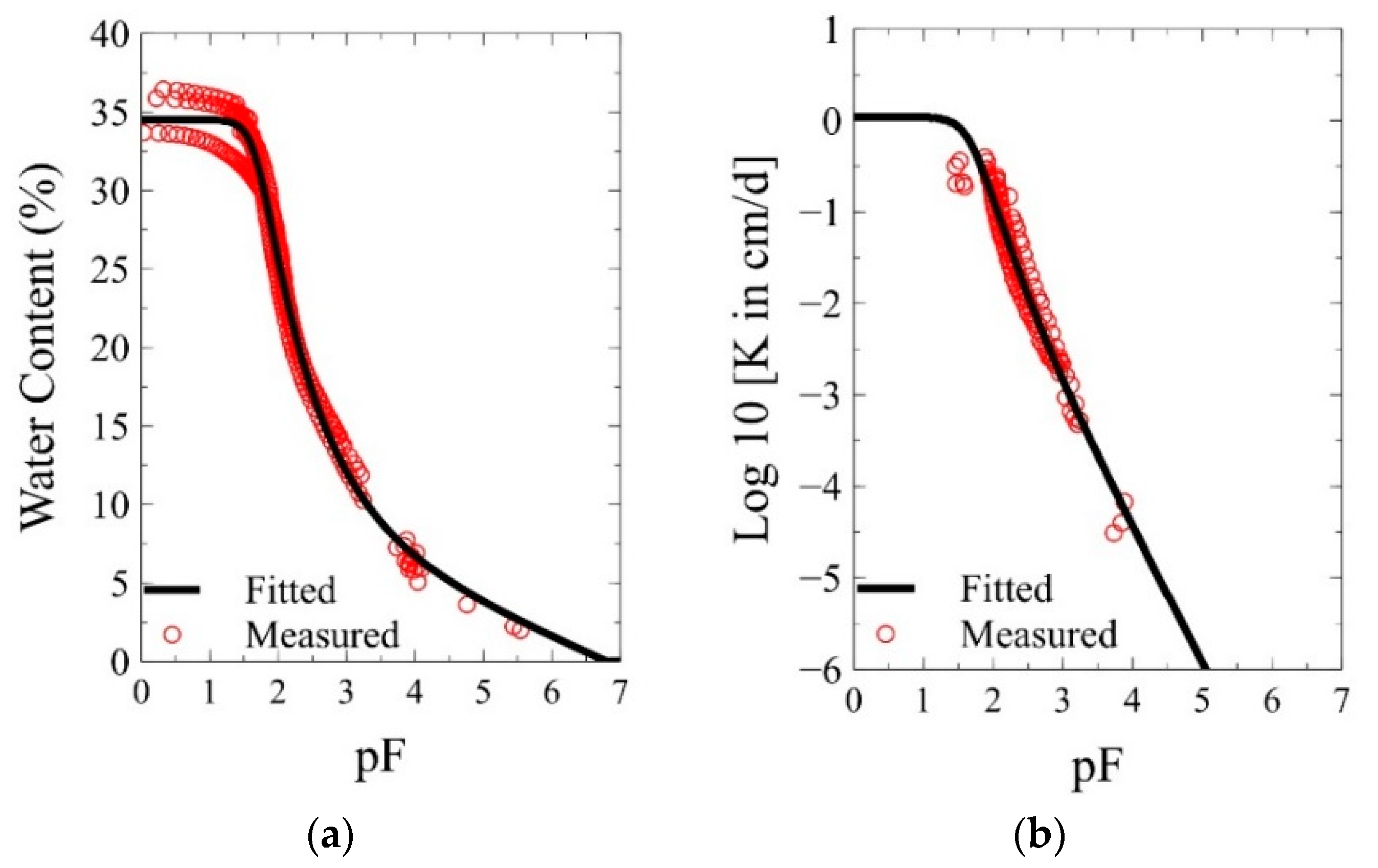

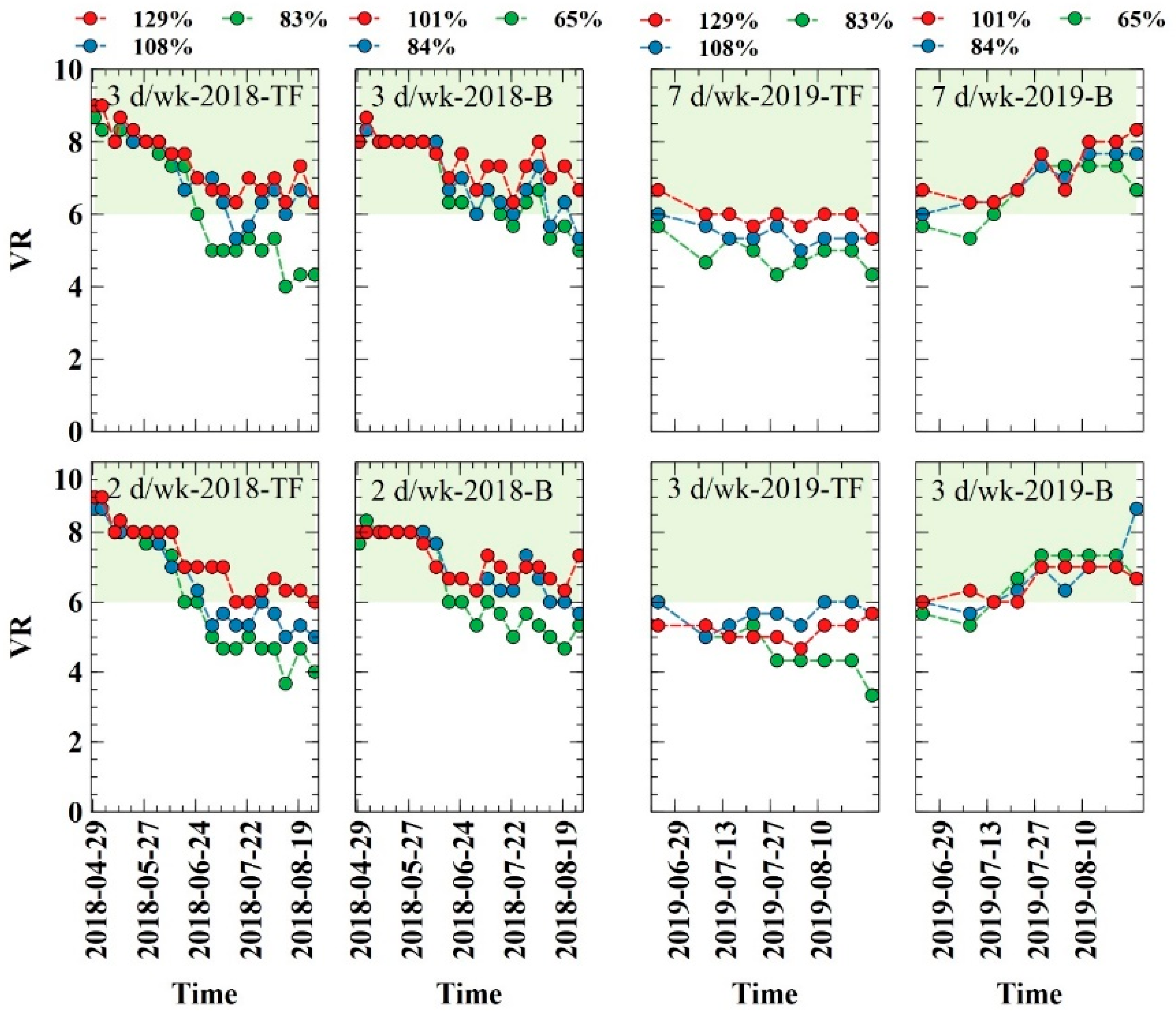
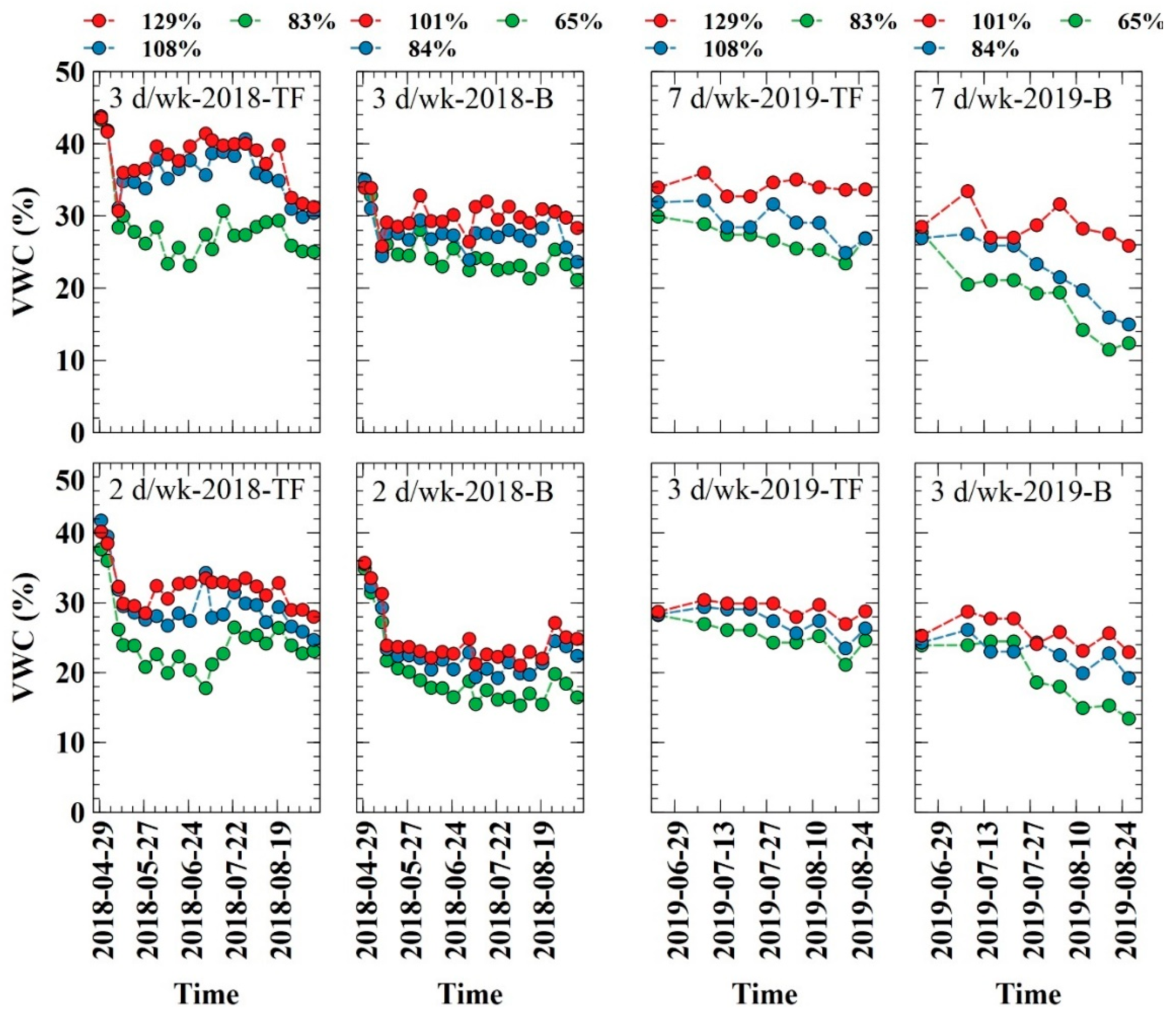
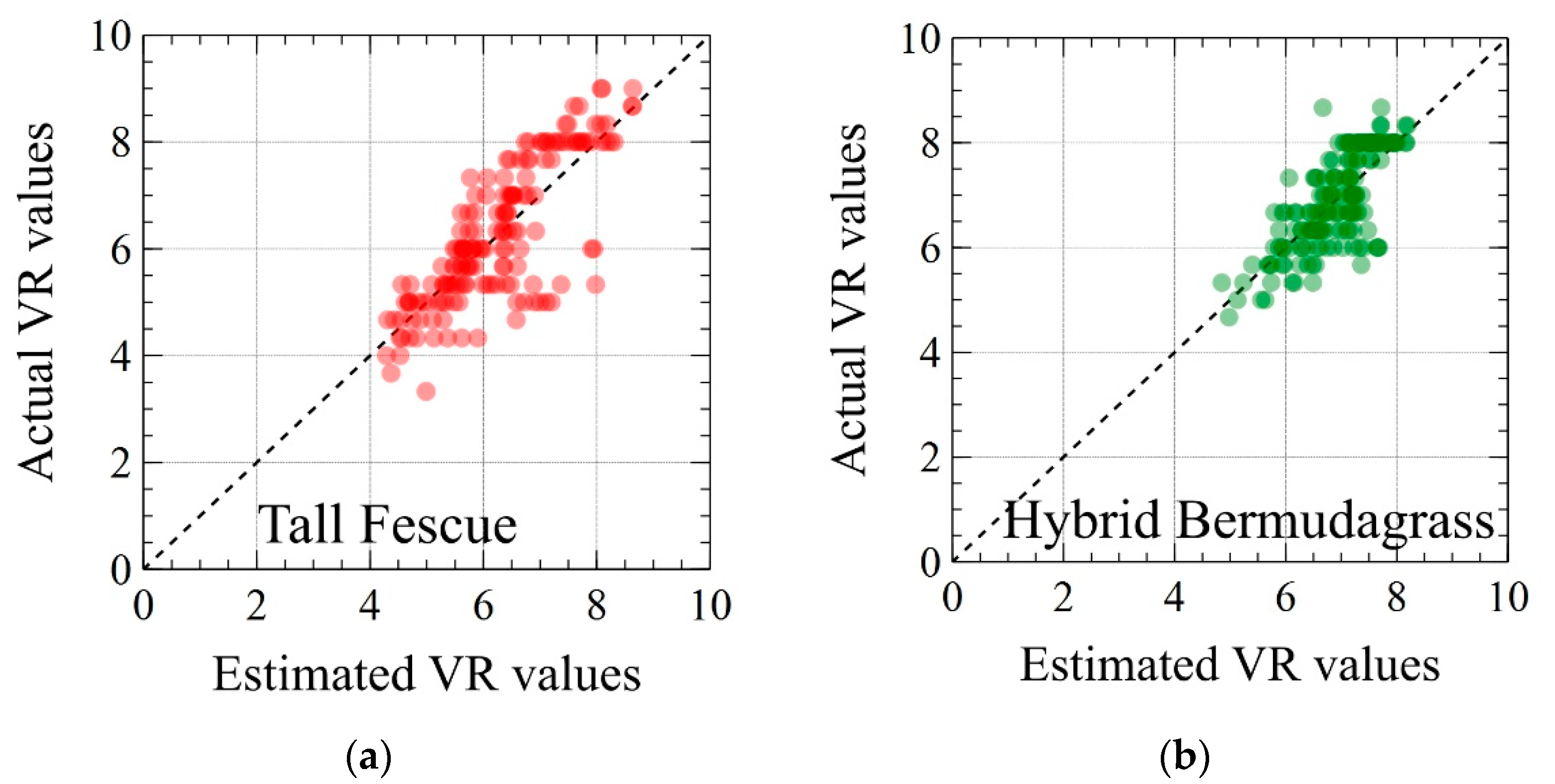

| 2018 Trial, Start: 4 May 2018; End: 11 September 2018 |
| Target Irrigation Levels (% ETo): Tall Fescue: 50%, 65%, 80%; Hybrid Bermudagrass: 40%, 50%, 60% Irrigation Efficiency: 78% |
| Watering Days: 2 days per week, 3 days per week |
| 2019 Trial, Start: 22 June 2019; End: 26 August 2019 |
| Target Irrigation Levels (% ETo): Tall Fescue: 50%, 65%, 80%; Hybrid Bermudagrass: 40%, 50%, 60% Irrigation Efficiency: 78% |
| Watering Days: 3 days per week, 7 days per week (no restriction) |
| Tall Fescue | Hybrid Bermudagrass | |||||
|---|---|---|---|---|---|---|
| Irrigation | T1 | T2 | T3 | T1 | T2 | T3 |
| Treatment | 50% | 65% | 80% | 40% | 50% | 60% |
| Programmed | 64% | 83% | 103% | 51% | 64% | 77% |
| Applied | 83% | 108% | 129% | 65% | 84% | 101% |
| Tall Fescue | Hybrid Bermudagrass | ||||
|---|---|---|---|---|---|
| Treatment | 2018 | 2019 | Treatment | 2018 | 2019 |
| Level | Level | ||||
| 129% ETo | 7.4 a | 5.6 a | 101% ETo | 7.4 a | 6.8 a |
| 108% ETo | 6.9 b | 5.6 ab | 84% ETo | 7.1 ab | 6.8 a |
| 83% ETo | 6.3 c | 4.9 b | 65% ETo | 6.7 b | 6.3 a |
| Frequency | Frequency | ||||
| 2 d wk−1 | 6.7 b | 2 d wk−1 | 6.9 a | ||
| 3 d wk−1 | 7.0 a | 5.2 a | 3 d wk−1 | 7.1 a | 6.4 a |
| 7 d wk−1 | 5.5 a | 7 d wk−1 | 6.8 a | ||
| Model effect | 2018 | 2019 | Model effect | 2018 | 2019 |
| I | *** | NS | I | * | NS |
| F | * | NS | F | NS | NS |
| I × F | NS | NS | I × F | NS | NS |
| T | *** | *** | T | *** | *** |
| I × T | *** | * | I × T | *** | NS |
| F × T | NS | NS | F × T | NS | NS |
| I × F × T | NS | NS | I × F × T | NS | NS |
| r1 | RMSE | MBE | MAE | |
|---|---|---|---|---|
| Tall Fescue | 0.79 | 0.64 | 0.0005 | 0.59 |
| Hybrid Bermudagrass | 0.75 | 0.37 | −0.0032 | 0.47 |
Publisher’s Note: MDPI stays neutral with regard to jurisdictional claims in published maps and institutional affiliations. |
© 2021 by the authors. Licensee MDPI, Basel, Switzerland. This article is an open access article distributed under the terms and conditions of the Creative Commons Attribution (CC BY) license (https://creativecommons.org/licenses/by/4.0/).
Share and Cite
Haghverdi, A.; Reiter, M.; Sapkota, A.; Singh, A. Hybrid Bermudagrass and Tall Fescue Turfgrass Irrigation in Central California: I. Assessment of Visual Quality, Soil Moisture and Performance of an ET-Based Smart Controller. Agronomy 2021, 11, 1666. https://doi.org/10.3390/agronomy11081666
Haghverdi A, Reiter M, Sapkota A, Singh A. Hybrid Bermudagrass and Tall Fescue Turfgrass Irrigation in Central California: I. Assessment of Visual Quality, Soil Moisture and Performance of an ET-Based Smart Controller. Agronomy. 2021; 11(8):1666. https://doi.org/10.3390/agronomy11081666
Chicago/Turabian StyleHaghverdi, Amir, Maggie Reiter, Anish Sapkota, and Amninder Singh. 2021. "Hybrid Bermudagrass and Tall Fescue Turfgrass Irrigation in Central California: I. Assessment of Visual Quality, Soil Moisture and Performance of an ET-Based Smart Controller" Agronomy 11, no. 8: 1666. https://doi.org/10.3390/agronomy11081666
APA StyleHaghverdi, A., Reiter, M., Sapkota, A., & Singh, A. (2021). Hybrid Bermudagrass and Tall Fescue Turfgrass Irrigation in Central California: I. Assessment of Visual Quality, Soil Moisture and Performance of an ET-Based Smart Controller. Agronomy, 11(8), 1666. https://doi.org/10.3390/agronomy11081666






